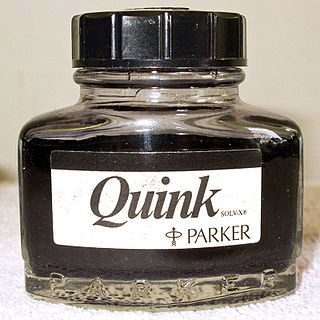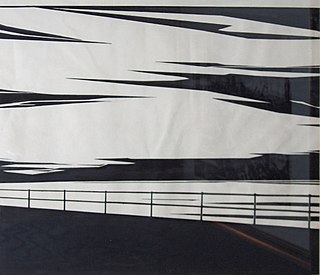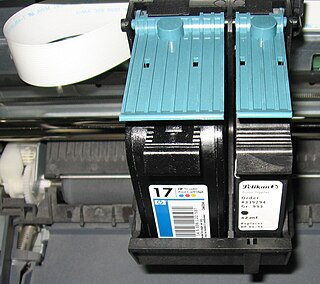 W
WInk is a gel, sol, or solution that contains at least one colourant, such as a dye or pigment, and is used to color a surface to produce an image, text, or design. Ink is used for drawing or writing with a pen, brush, reed pen, or quill. Thicker inks, in paste form, are used extensively in letterpress and lithographic printing.
 W
WBlack light paint or black light fluorescent paint is luminous paint that glows under a black light. It is based on pigments that respond to light in the ultraviolet segment of the electromagnetic spectrum. The paint may or may not be colorful under ordinary light. Black light paint should not be confused with phosphorescent (glow-in-the-dark) or daylight fluorescent paint.
 W
WCephalopod ink is a dark-coloured or luminous ink released into water by most species of cephalopod, usually as an escape mechanism. All cephalopods, with the exception of the Nautilidae and the Cirrina, are able to release ink.
 W
WElectoral ink, indelible ink, electoral stain or phosphoric ink is a semi-permanent ink or dye that is applied to the forefinger (usually) of voters during elections in order to prevent electoral fraud such as double voting. It is an effective method for countries where identification documents for citizens are not always standardised or institutionalised. Election ink uses silver nitrate, and excessive exposure can cause argyria. It was first used during the 1962 Indian general election, in Mysore State, now the modern-day state of Karnataka.
 W
WErythrosine, also known as Red No. 3, is an organoiodine compound, specifically a derivative of fluorone. It is a pink dye which is primarily used for food coloring. It is the disodium salt of 2,4,5,7-tetraiodofluorescein. Its maximum absorbance is at 530 nm in an aqueous solution, and it is subject to photodegradation.
 W
WFlo-Master was a brand of inks and markers in the latter half of the 20th century, remembered particularly for the colorful opacity of the inks. These markers were designed for marking on glass, and became weapons of choice among New York City writers of the Original School of NYC Writin' in the 1970s and early 1980s.
 W
WFountain pen ink is a water-based ink intended for use with fountain pens.
 W
WIndia ink is a simple black or coloured ink once widely used for writing and printing and now more commonly used for drawing and outlining, especially when inking comic books and comic strips. India ink is also used in medical applications.
 W
WAn ink ball, inking ball, or dabber was a tool used in printmaking and letterpress printing to apply ink to the plate or type to be printed.
 W
WAn ink cartridge or inkjet cartridge is a component of an inkjet printer that contains the ink that is deposited onto paper during printing.
 W
WAn inkjet refill kit is a set of tools and ink used to refill ink cartridges. The specific tools and the amount or type of ink depends on which cartridge the kit is designed for. The purpose of an inkjet refill kit for consumers is that it offers a low-cost alternative to buying original, genuine cartridges.
 W
WInksticks (Chinese: 墨 Mò; or ink cakes are a type of solid ink Chinese ink used traditionally in several East Asian cultures for calligraphy and brush painting. Inksticks are made mainly of soot and animal glue, sometimes with incense or medicinal scents added. To make ink, the inkstick is ground against an inkstone with a small quantity of water to produce a dark liquid which is then applied with an ink brush. Artists and calligraphers may vary the concentration of the resulting ink according to their preferences by reducing or increasing the intensity and duration of ink grinding.
 W
WIron gall ink is a purple-black or brown-black ink made from iron salts and tannic acids from vegetable sources. It was the standard ink formulation used in Europe for the fourteen-hundred-year period between the 5th and 19th centuries, remained in widespread use well into the 20th century, and is still sold today.
 W
WLithol Rubine BK is a reddish synthetic azo dye. It has the appearance of a red powder and magenta when printed. It is slightly soluble in hot water, insoluble in cold water, and insoluble in ethanol. When dissolved in dimethylformamide, its absorption maximum lies at about 442 nm. It is usually supplied as a calcium salt. It is prepared by azo coupling with 3-hydroxy-2-naphthoic acid. It is used to dye plastics, paints, printing inks, and for textile printing. It is normally used as a standard magenta in the three and four color printing processes.
 W
WPlastisol is a suspension of polyvinyl chloride (PVC) or other polymer particles in a liquid plasticizer; it flows as a liquid and can be poured into a heated mold.
 W
WSolid ink is a type of ink used in printing. Solid ink is a waxy resin-based polymer that must be melted prior to usage, unlike conventional liquid inks. The technology is used most in graphics and large format printing environments, where color vividness and cost efficiency are important.
 W
WThermochromism is the property of substances to change color due to a change in temperature. A mood ring is an excellent example of this phenomenon, but thermochromism also has more practical uses, such as baby bottles which change to a different color when cool enough to drink, or kettles which change when water is at or near boiling point. Thermochromism is one of several types of chromism.